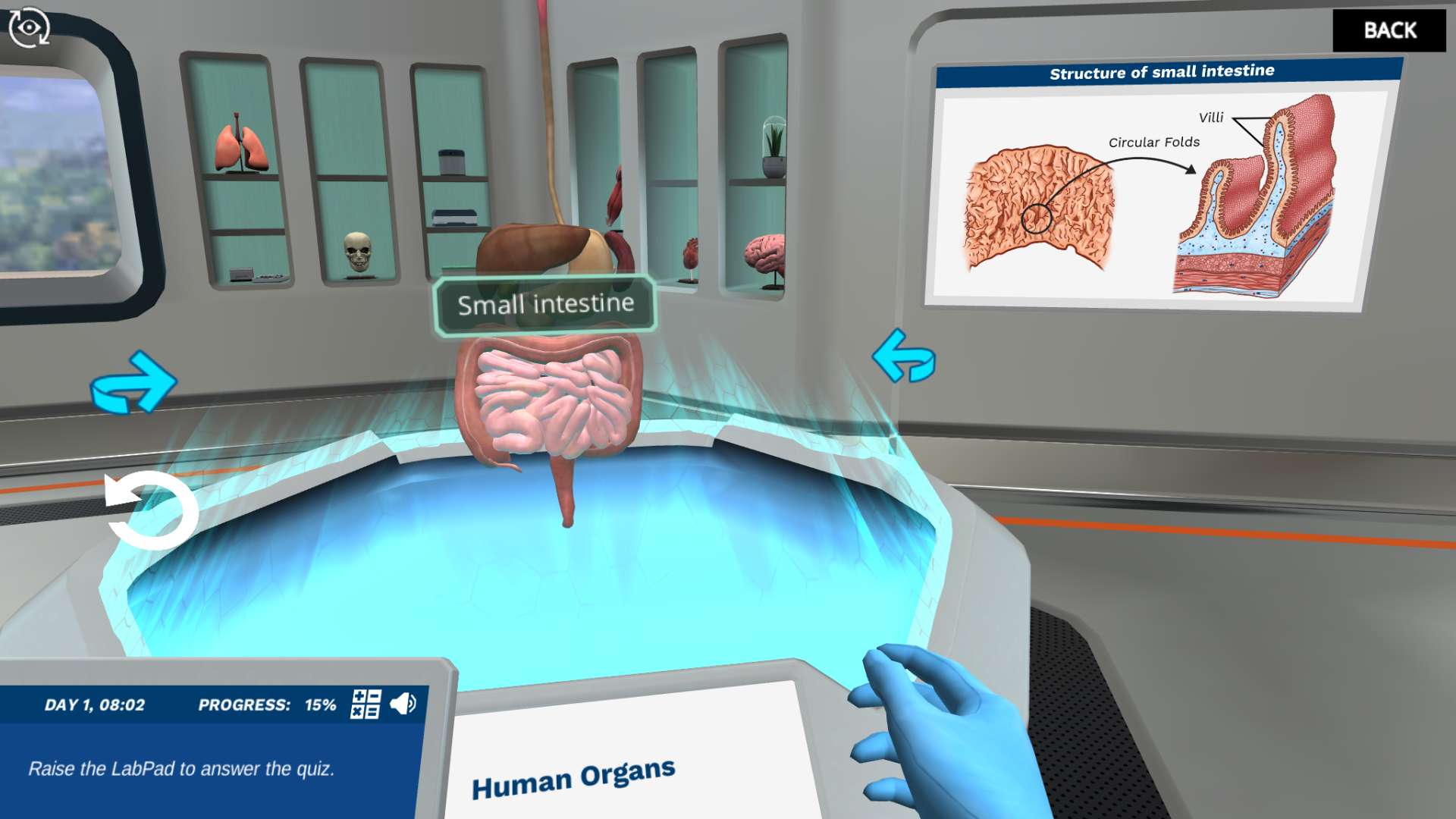Heading 1
Heading 2
Heading 3
Heading 4
Heading 5
Heading 6
Lorem ipsum dolor sit amet, consectetur adipiscing elit, sed do eiusmod tempor incididunt ut labore et dolore magna aliqua. Ut enim ad minim veniam, quis nostrud exercitation ullamco laboris nisi ut aliquip ex ea commodo consequat. Duis aute irure dolor in reprehenderit in voluptate velit esse cillum dolore eu fugiat nulla pariatur.
Block quote
Ordered list
- Item 1
- Item 2
- Item 3
Unordered list
- Item A
- Item B
- Item C
Bold text
Emphasis
Superscript
Subscript
About This Simulation
In this simulation, you will step into the Anatomy and Physiology lab to discover how essential your intestines are in maintaining human life. Investigate what happens if your intestines malfunction and learn why you really need to eat your veggies!
Learning Objectives
- Compare the wall composition of small and large intestine and relate this to their function
- Explore the function of the villi in the lining of the small intestine
- Detail the implications of dysfunction of absorption in the small and large intestine
About This Simulation
Lab Techniques
Related Standards
- Early Stage Bachelors Level
- EHEA Second Cycle
- US College Year 1
- US College Year 2
- US College Year 3
- EHEA First Cycle
Learn More About This Simulation
What twisted tubes your lunch must travel through to transform into energy! In this simulation, you will learn about nutrient absorption in the small and large intestines and the implications of the intestines malfunctioning.
Functions and cells of the intestines
Begin with identifying the small and large intestines on the human 3D model and aligning the functions of these organs with their structures. Do they have any roles other than absorption? Investigate which cells build intestines and how they facilitate their functions. Are some cell types more common in the small intestine than in the large intestine? Do intestines share common features, or are they completely different?
Complexity of the small intestine
Jump into an animation and follow a piece of food on its journey throughout the small intestine. Observe how the food gets into the intestine and discover various structures aiding the absorption of nutrients. In the virtual intestine, you will learn what a brush border is and whether it really brushes your food before you absorb it into the bloodstream!
Implications of malnutrition
Analyze the implications of the dysfunction of the small and large intestine by matching the lack of a particular nutrient with its corresponding consequences (and visible symptoms). Can the lack of vitamin D have a negative impact on your hair and muscles? What effect can protein deficiency have on your breath? Talk to our scientists and discover the connections between malnutrition and common intestinal diseases.
For Science Programs Providing a Learning Advantage
Boost STEM Pass Rates
Boost Learning with Fun
75% of students show high engagement and improved grades with Labster
Discover Simulations That Match Your Syllabus
Easily bolster your learning objectives with relevant, interactive content
Place Students in the Shoes of Real Scientists
Practice a lab procedure or visualize theory through narrative-driven scenarios


FAQs
Find answers to frequently asked questions.
Heading 1
Heading 2
Heading 3
Heading 4
Heading 5
Heading 6
Lorem ipsum dolor sit amet, consectetur adipiscing elit, sed do eiusmod tempor incididunt ut labore et dolore magna aliqua. Ut enim ad minim veniam, quis nostrud exercitation ullamco laboris nisi ut aliquip ex ea commodo consequat. Duis aute irure dolor in reprehenderit in voluptate velit esse cillum dolore eu fugiat nulla pariatur.
Block quote
Ordered list
- Item 1
- Item 2
- Item 3
Unordered list
- Item A
- Item B
- Item C
Bold text
Emphasis
Superscript
Subscript
A Labster virtual lab is an interactive, multimedia assignment that students access right from their computers. Many Labster virtual labs prepare students for success in college by introducing foundational knowledge using multimedia visualizations that make it easier to understand complex concepts. Other Labster virtual labs prepare learners for careers in STEM labs by giving them realistic practice on lab techniques and procedures.
Labster’s virtual lab simulations are created by scientists and designed to maximize engagement and interactivity. Unlike watching a video or reading a textbook, Labster virtual labs are interactive. To make progress, students must think critically and solve a real-world problem. We believe that learning by doing makes STEM stick.
Yes, Labster is compatible with all major LMS (Learning Management Systems) including Blackboard, Canvas, D2L, Moodle, and many others. Students can access Labster like any other assignment. If your institution does not choose an LMS integration, students will log into Labster’s Course Manager once they have an account created. Your institution will decide which is the best access method.
Labster is available for purchase by instructors, faculty, and administrators at education institutions. Purchasing our starter package, Labster Explorer, can be done using a credit card if you are located in the USA, Canada, or Mexico. If you are outside of North America or are choosing a higher plan, please speak with a Labster sales representative. Compare plans.
Labster supports a wide range of STEM courses at the high school, college, and university level across fields in biology, chemistry, physics, and health sciences. You can identify topics for your courses by searching our Content Catalog.















